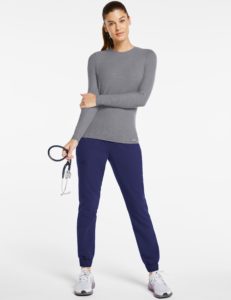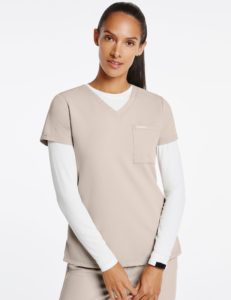
How To Mix and Match Different Scrubs Colors and Styles
Even if you don’t work in the industry, all you have to do is walk into a healthcare facility or shop for scrubs online to know that medical scrubs come in almost every color of the rainbow. But if you are a medical professional, you also know quality scrubs come in different styles that can be mixed and matched for seemingly endless combinations.
But why do we mix and match scrubs? Is there a reason behind it? Well, sometimes it’s a necessity. Maybe one-half of your pair of scrubs finally fell apart in the wash, and you have to improvise on short notice. Perhaps another part of your nursing scrubs is already dirty, so you’re left with a temporary replacement until it’s clean.
Or perhaps you simply wanted to spice things up a bit with a cute, creative uniform. If so, the sky’s the limit, as experimenting with mismatching scrubs is an easy method to do just that. (Well, almost the limit; you still have to keep that dress code in mind.)
Whatever the case, mixing and matching scrubs outfits is a common practice among healthcare professionals. Chances are likely that you already do so yourself. Nevertheless, nursing uniforms and workwear can’t just be haphazardly slapped together. There needs to be intent behind it.
Think of it this way: Did you mix and match? Or did you simply mismatch?
Read on for a list of handy tips on mixing and matching scrub color combinations.
How to mix and match different colors of scrubs

There are three basic ways of mixing and matching your scrubs tops and bottoms. You can pair different patterned fabrics, different colors and different styles of scrubs. And, of course, you can combine pieces with underscrubs, contrast colors and different styles, too. Here are some basic tips to keep in mind:
Mixing patterns with solid colors
Just like it sounds, you’re taking a print top or pair of scrub pants with a pattern like florals or polka dots and matching it with a solid-color scrub item to create a one-of-a-kind combination.
These two items will likely have a different style of cut. If so, to create a more seamless appearance, look for a pattern that’s easy on the eyes and not too busy. You’ll also want to pair that small, subtle print with a scrub top or pant of a similar color. This way, you’ll draw attention away from different styles by highlighting their similarities, creating a flattering, polished look.
Mixing different styles of scrubs
When you mix different scrubs, it often shows that they’re not cut from the same cloth. That’s because different styles are generally made out of different fabric types.
To counteract this difference, you’ll once again want to minimize disparate weaves and draw attention to the similarities, namely, the color. One of the easiest ways to do this is by matching the color of your scrub top and scrub pants to create a striking, monochromatic look from head to toe.
Mixing different scrub colors
Lastly, you can mix and match different colors while keeping the cut the same. But keep in mind, this technique may prove harder than it looks.
The reason for this? Your workplace may have specific rules about what scrub colors you can wear, depending on your position or department. Specific color combinations, while beautiful, may also cause eye strain or unintentionally induce emotional stress in patients. The meaning behind scrub colors can denote something specific like your ranking or department, too.
On the flip side, a gentle color combination like navy blue scrub pants and a light gray scrub top can inspire calmness among coworkers and patients alike and help instill a relaxing atmosphere in any healthcare setting.
Do’s and don’ts when putting together a scrub outfit

Here’s a handy list of do’s and don’ts when mismatching scrubs.
Do buy scrubs that match your skin tone
Mixing your scrubs can be a lot of fun, but if you don’t consider how those scrubs will look on you in actuality, all that creativity will go to waste. A good rule of thumb:
Always remember that there are two primary undertones for skin color, cool and warm, with various intensities between them.
If your complexion has a warm undertone, neutral colors, such as cream and soft brown, will look excellent, along with warmer reds, oranges and yellows.
Suppose your skin is on the cooler end. Jewel-toned colors will suit your wintery complexion. Think deep purples, bright blues, burgundy, grays and navy.
Do ask yourself, “How will this color make my patients feel?”
What color scrubs do doctors wear? How about nurses and nursing assistants? Well, it all depends on the patient.
Too many bright colors in one spot can cause significant eyestrain for others. Specific colors, like bright red, are also very busy, and other colors, like black, can tip too far over into the “doom and gloom” scale, especially when worn in excess.
This doom and gloom is the very last thing you want when you need your patients to focus on getting better.
Don’t buy a scrub color that will get dirty easily
All scrubs eventually get dirty, but you should be washing your scrubs regularly, regardless of how quickly that happens. Remember, some scrubs show dirt more than others, depending on the color and the daily tasks you’re completing. Ask yourself what type of fluids and contaminants you’re exposed to regularly, and be practical about your color choices.
Importance of colored scrubs in healthcare

Keep in mind the overall importance of color-coded scrubs in a healthcare setting and what mixing and matching those colors can convey to the public.
You can get an idea of what color scrubs are out there by shopping Jaanuu’s full scrub selection or checking out our men’s bestselling scrubs.
If you’re looking for a quick breakdown of the most popular choices, here’s a quick cheat sheet:
- White: This is a color that has been historically associated with the nursing profession, and it can create a very striking silhouette. However, bright white can be harsh on the eyes under the even-brighter lights of a hospital.
- Blue: It’s one of the most common colors in scrubs and also the safest. Not only is it easy on the eyes, but different shades of blue tend to have a calming effect.
- Green: Similar to blue, it’s another color that’s easy on the eyes, although we should stress that this one has been (and still very much is) associated with surgeons. Your workplace might have specific rules around wearing this shade or specific hues of it.
- Black: Black is a flattering choice that can often denote authority. But try to keep your wardrobe varied. Patients tend to love color.
- Pink: Gentle in its chromatic intensity and easy on the eyes, pink scrubs, especially baby pink, can be nurturing. It’s a particularly great color for nurses who work with children.
- Purple: Although this is a flattering color for those with cool skin tones and can hide stains easily, opinions on this hue are often mixed. It’s sometimes seen as less conservative and professional than its close counterpart, the classic blue scrub set.
- Wine: A dressier, more subdued version of a red scrub set, wine or burgundy scrubs are easy on the eyes, hide stains well and can be flattering to boot.
If you’re looking to mix and match your daily uniform, check out our handy scrub set builder. Have fun and don’t be afraid to express the realest you!